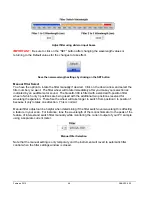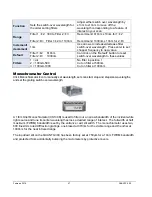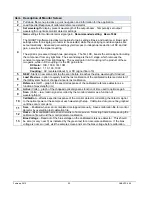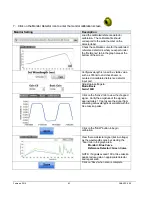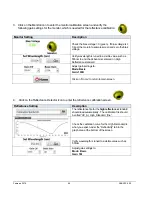
February 2019
54
QUANTX-300
Item Description of First Reflection Screen
1
Pull down file menu provides a quick navigation and information for the application
2
High reflectance file for high reflectance standard
3
Set wavelength
/ display present wavelength of the output beam. Temporarily set output
wavelength to optimize reflectance detector settings
4
Gain
settings for monitor reflectance signal gain. For optimal estimation of the reflectance and
IQE, the amplitude of the active signal should be approximately 1-2 V
The QUANTX software provides two options for gain settings, Basic and Advanced. Basic gain
settings allow for a single gain factor to be selected, while the underlying constituent gains are set
automatically. Advanced gain settings yield access to independent selection of DC and AC gain,
as well as the signal coupling.
The signal is processed through two gain stages. The first, DC, boosts the entire signal including
the component from any light bias. The second stage is the AC stage, which removes the
constant component from light biasing. The overall gain in AC coupling is the product of these
two gains, while in DC coupling it is the DC gain alone.
DC Gain
= 10K, 100K, 1M, 10M
AC Gain
= 1, 10, 100, 1000
Coupling
= AC (centered about 0) or DC (signal floor of 0)
5
NEW
- Starts a new scan and stop the scan before it reaches the stop wavelength, if desired
6
Load Previous
- option to quickly load the last calibration of the high reflectance detector if the
IQE system has not changed since its last calibration
7
Reflectivity
(x100%) – graph of the reflectivity of the high reflectance standard as a function of
wavelength (nm)
8
Active
(Volts) – graph of the chopped optical signal as function of time used to optimize gain
values and tip/tilt of the sample stage
9
Scan
(Volts) – signal recorded by the reflectance detector using the high reflectance standard as
a target as a function of wavelength (nm).
10
Calibration
– slope “m” and intercept “n” for relating the reflectance detector signal to sample
reflectivity.
This cannot be graphed on this screen until the low reflectance standard has
completed.
11
Save
– Enabled when scan is completed or stopped manually. Saves calibration file for high
reflectance sample by overwriting last calibration file. Calibration must be saved to continue to the
low reflectance calibration step.
12
Home
– Exits calibration screen and returns to home screen. Selecting home on this screen will
void the reflectance detector calibration.
To advance to the second reflectance calibration screen, a reflectance file should automatically load
(2), select New (5) or Load Previous (6), and Save (11) the results. The second calibration will
replace the first screen.







